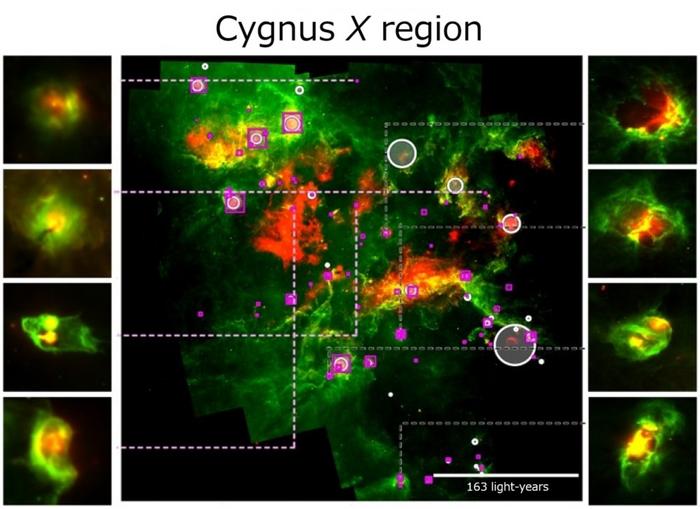Japanese researchers at Osaka Metropolitan University have introduced an innovative approach to explore the complex formations within our galaxy using deep learning techniques. This pioneering study focuses on the enigmatic bubble-like structures identified through precise infrared observations captured by the Spitzer Space Telescope. Unlike standard observational methods that heavily rely on existing astronomical databases, this research relies on cutting-edge artificial intelligence to uncover previously unrecognized spatial phenomena related to star formation.
Establishing a sophisticated deep learning model, graduate student Shimpei Nishimoto and Professor Toshikazu Onishi led a collaborative effort involving scientists from various institutions throughout Japan. This model utilizes advanced AI algorithms to sift through extensive datasets derived from both the Spitzer and James Webb Space Telescopes, thus enabling the detection of Spitzer bubbles with remarkable efficiency and accuracy. The implications of their findings extend not only to our understanding of star formation processes but also to significant insights concerning the evolutionary trajectory of our galaxy.
The Milky Way, similar to other galaxies in the cosmos, is populated with bubble-like formations primarily produced during the lifecycle of high-mass stars. These bubble structures serve as critical indicators to assess the underlying mechanisms of star formation and the broader dynamics of galaxy evolution. The Spitzer bubbles themselves encapsulate vital information, allowing astronomers to enhance their grasp of how stars evolve over time.
In the course of their research, the team identified not only the standard bubble structures but also unique shell-like formations believed to have emerged from supernova explosions. Such discoveries are not merely academic; they hold powerful implications for the future of astronomical studies. The results signify a major leap forward in utilizing AI for astronomical research, presenting an opportunity to address challenging questions related to explosive galactic occurrences and their consequent effects on star formation patterns.
Nishimoto remarked on the potential of their findings by stating, “Our results showcase the capability of deep learning methodologies not only to delve deeper into the complex processes associated with star formation but also to analyze the impacts of explosive events within galaxies.” This opens avenues for future investigations that could provide unprecedented insights into the characteristics and dynamics of our cosmic neighborhood.
In addition to the advancements in detection capabilities, the integration of AI technologies into astronomy may significantly streamline and enhance the data analysis phase of astronomical research. The sheer volume of data released from space telescopes has long posed a challenge, hindering researchers from fully capitalizing on the wealth of information available. Through deep learning techniques, researchers can efficiently analyze and interpret astronomical data, leading to new discoveries and realizations.
As this line of research continues to develop, it is becoming increasingly evident that artificial intelligence will play a pivotal role in unraveling the mysteries of galactic evolution and star formation mechanisms. The continuous advancements in AI technologies promise a brighter future for researchers looking to explore the universe and its myriad phenomena.
Moreover, the implications of this work transcend mere data analysis; they resonate within the wider scientific community. Other fields may take note of the methodologies laid out by Nishimoto and Onishi’s work, potentially adapting similar techniques to uncover hidden patterns in different types of research. Such interdisciplinary applications of AI could propel forward not only astronomy but various scientific realms that grapple with extensive datasets.
As researchers at Osaka Metropolitan University seek to refine and expand upon their discoveries, they remain optimistic about the future trajectory of astronomical research influenced by artificial intelligence. Future iterations of their deep learning model could be employed in larger studies, enabling even more profound insights into the universe’s mysteries.
The commitment of Osaka Metropolitan University to further scientific knowledge through innovative research practices speaks to the potential of higher education institutions to lead in the pursuit of understanding complex scientific topics. The collaborative spirit seen among the researchers mirrors a growing trend in the scientific community to engage multiple disciplines in tackling intricate questions regarding the nature of the cosmos.
Nishimoto and Onishi, along with their team, continue to inspire curiosity about our galaxy’s fundamental processes. Their work serves as a reminder of the ever-evolving interface between technology and exploration and how the integration of innovative approaches can yield transformative insights into our universe.
As we look to the future, we remain vigilant and fascinated by the ongoing developments in the field of astronomy, eagerly anticipating the groundbreaking discoveries yet to emerge from the convergence of artificial intelligence and astronomical study.
Subject of Research:
Article Title: Infrared Bubble Recognition in the Milky Way and Beyond Using Deep Learning
News Publication Date: 17-Mar-2025
Web References:
References:
Image Credits: Osaka Metropolitan University
Keywords
Deep learning, Spitzer bubbles, astronomical studies, star formation, galaxy evolution, artificial intelligence, data analysis, cosmic phenomena, interdisciplinary science, observational astronomy.




